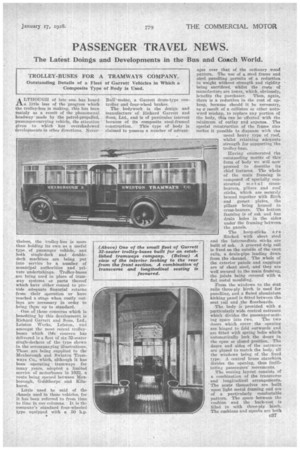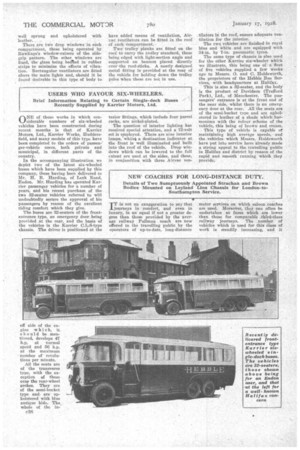PASSENGER TRAVEL NEWS.
Page 59

Page 60

If you've noticed an error in this article please click here to report it so we can fix it.
The Latest Doings and Developments in the Bus and Coach World.
TROLLEY-BUSES FOR A TRAMWAYS COMPANY. Outstanding Details of a Fleet of Garrett Vehicles in Which a Composite Type of Body is Used.
ALTHOUGII of late one. has heard a little less of the progress which the trolley-bus is making, this has been mainly as a result of the phenomenal headway made by the petrol-propelled, passenger-carrying vehicle, the attention given to which has overshadowed developments in other directions. Never theless, the, trolley-bus is more than holding its own as a useful type of passenger vehicle, and both single-deck and doubledeck machines are being put into service by a number of municipal authorities and private undertakings. Trolley-buses are being used in place of tramway systems or parts thereof which have either ceased to provide adequate financial returns from their operation or have reached a stage when costly outlays are necessary in order to -bring tkm upto standard. .
One of those concerns which is benefiting by this development is Richard Garrett and Sons, Ltd., Leiston Works, Leistou, and amongst the most recent trolleybuses which this concern has delivered is a fleet of six 32-seater single-deckers of the type shown in the accompanying illustrations. These are being supplied to the Mexhorough and Swinton Tramways Co., which, although it has been operating tramways for many years, adopted a limited service of motorbuses in 1922 a route being opened between Mexborough, Goldthorpe and Kilnhurst.
Little need be said of the chassis used in these vehicles, for It has been referred to from time to time in our columns: It is the company's standard four-wheeled type equipped with • a 50 h.p.
Bull, motor, a Garrett drum-type controller and four-wheel brakes.
The bodywork is the design and manufacture of Richard Garrett and Sons, Ltd., and is of particular interest because of its composite steel-framed construction. This type of body is claimed to possess a number of advent
ages over that of the ordinary wood pattern. The use of a steel frame and steel panelling permits of a reduction in weight without strength and rigidity being sacrificed, whilst the costs of manufacture are lower,, which, obviously,
benefits the purchaser. Then, .again, there is a reduction in the cost of upkeep, because should it be necessary, as it result of a collision or other untoward mishap, to replace any portion of the body, this can be effected with the minimum of outlay and expense. The special construction of the frame also makes it possible to dispense with the usual heavy type of roof, whilst retaining addquate strength for supporting the trolley-base.
Having enumerated the outstanding merits of this' form of body we will now proceed to describe its chief features. The whole of the main framing is composed r4 specially constructed m et al crestbearers, pillars and roof sticks, which are securely braced together with flitch and gusset plates, the pillars being housed in cross-bearers. The bottom framing is of ash and has drain holes in the sides nuclei the framing' between the panels.
The hoop-sticks are flitched with sheet steel and the intermediate sticks are built of ash. A grooved drip rail is fixed on the outside of the cant rails, a drain-pipe leadiug down from the channel. The whole of the exterior panels and cappings are of sheet steel, and they are well secured to the main framing, the joints being revered with a flat metal moulding.
From the windows to the seat rails three-ply birch is used for panelling, and a fluted aluminium kicking panel is fitted between the seat rail and the floorboards.
The body is provided with a' particularly wide central entrance which divides the passenger-seat
ing space into two. The two doors which cover the opening are hinged to fold outwards and are fitted with spring bolts which automatically lock the doors in the open or closed position. The doors and sides of the entrance are glazed to match the body, all the windows being of the fixed type. A central brass stanchion divides the opening, thus facilitating passengers' movements.
The seating layout consists of a combination of the transverse and longitudinal arrangements. The seats themselves are built upon light metal framing and are of a particularly comfortable
pattern. The space between the cushion and the back-rest is filled in with three-ply birch. The cushions and squabs are bath
well sprung and upholstered with leather.
There are two drop windows in each compartment, these being operated by Rawlings's window-raisers of the sidegrip pattern. The other windows are fixed, the glass being befitted in rubber strips to minimize the effects of vibration. Rectangular ventilators are fitted above the main lights and, should it be found desirable in this type of body to have added means of ventilation, _Airvac ventilators can be fitted in the roof of each compartment. • Two trolley planks are fitted on the roof to carry the trolley standard, these being edged with light-section angle and supported on bearers placed directly over the roof-sticks. A neatly designed metal fitting is provided at the rear of the vehicle for holding down the trolley poles when these are not in use.












































































































